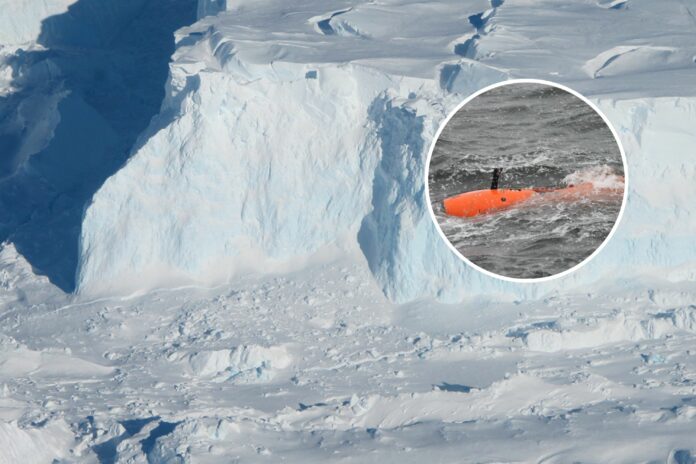An underwater vehicle has disappeared without a trace as it explored under the “Doomsday Glacier” in Antarctica.
The 23-foot unmanned underwater vehicle (AUV), named Ran, was on a mission studying the Thwaites Glacier when it went missing this weekend.
Ran is one of only three similar vehicles in the world, containing technology and sensors that allow it to measure and document the water conditions underneath glacial ice over long periods of time, and is estimated to cost about $3.6 million.
NASA/James Yungel / Anna Wåhlin
“This was the second time we took Ran to Thwaites Glacier to document the area under the ice. Thanks to Ran, we became the first researchers in the world to enter Thwaites in 2019, and during the current expedition we have visited the same area again. Even if you see melting and movements in the ice from satellite data, from Ran we get close-ups of the underside of the ice and information about exactly which mechanisms are behind the melting,” Anna Wåhlin, a professor of oceanography at the University of Gothenburg and member of the research team, said in a statement.
The Thwaites Glacier, which is part of the West Antarctic Ice Sheet (WAIS), is the widest glacier on Earth, and has a surface area of about 74,000 square miles, larger than the state of Florida and twice the size of Maine. Thwaites is also sometimes known as the Doomsday Glacier due to the impact it would have on global sea levels if it were to melt completely. It’s thought that sea levels would rise by an average of 25 inches—over 2 feet—across the world if the glacier were to collapse entirely.
There are also fears that Thwaites collapsing may trigger a chain reaction of other glaciers in the same area, possibly leading to several meters of sea level rise globally.
“A sea level rise of several meters would inundate many of the world’s major cities—including Shanghai, New York, Miami, Tokyo and Mumbai. It would also cover huge swathes of land in coastal regions and largely swallow up low-lying island nations like Kiribati, Tuvalu and the Maldives,” Ella Gilbert, a postdoctoral research associate in climate science at the University of Reading, U.K., wrote in an article for the Conversation in 2021.
Thwaites is already currently responsible for about 4 percent of global sea level rise, as it loses a net of roughly 50 billion tons of ice every year, and has lost about 1000 billion tons since the year 2000.
Ran investigates glaciers like Thwaites during dives underneath the ice, which can measure between 650 and 1,640 feet thick. Usually, Ran is not in constant contact with the research vessel—the South Korean icebreaker RV/IB Araon—on the surface, instead having its route preprogrammed and navigating its way back to the ocean surface. Ran had previously dived under Thwaites several times, but this time, something went awry, and Ran did not appear at the surface when it should have. Searches using acoustic search equipment, helicopters, and drones were unsuccessful, and Ran remains lost beneath the ice.
“It’s a bit like looking for a needle in a haystack, but without even knowing where the haystack is. At this point, Ran’s batteries are dead. All we know is that something unexpected happened under the ice. We suspect it ran into trouble, and then something prevented it from getting out,” Wåhlin said.
The team is not optimistic that they will find Ran again, but are grateful for the data it gathered thus far, as well as the support of the ship and expedition management.

“The data we receive from Ran is unique in the world, and of great value for international research. At the same time, the stakes are high, we knew something like this could happen, even that it’s a likely end for Ran,” Wåhlin said.
“Personally, I’m of the opinion that this is a better end than having the AUV aging gathering dust in a garage. At the same time, it is of course a very big loss. We have had Ran for five years now, and during those five years we have carried out about ten expeditions, training, development work and tests,” she said. “Our aim is to replace Ran.”
Do you have a tip on a science story that Newsweek should be covering? Do you have a question about glaciers? Let us know via [email protected].
Uncommon Knowledge
Newsweek is committed to challenging conventional wisdom and finding connections in the search for common ground.
Newsweek is committed to challenging conventional wisdom and finding connections in the search for common ground.


